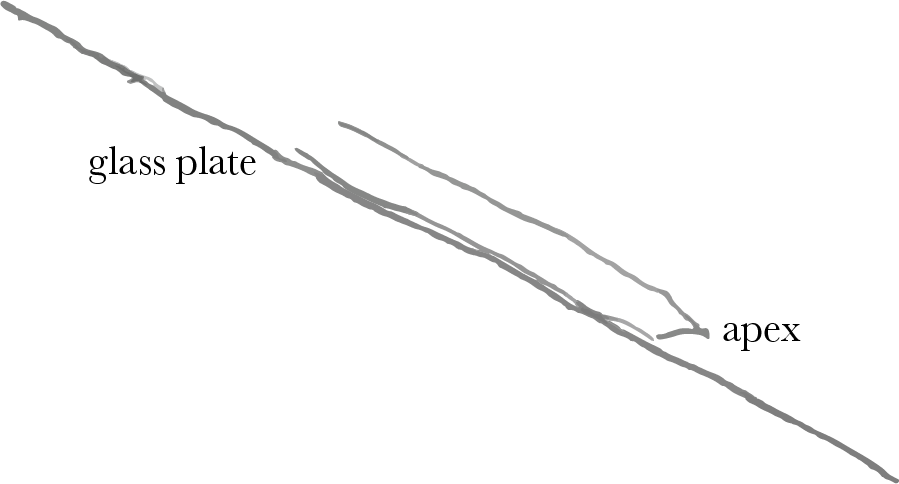To Francis Darwin 28 June [1879]1
Laura’s House
June 28th
My dear Frank
Here we are & remain till Tuesday morning, & George comes down to night.—2 I had a very busy day yesterday; first good talk with B. Sanderson who was interested about the circumnutation & starting movement under microscope of Dionæa & means to go into it in relation to electric currents:3 then a very pleasant luncheon at Pagets, & in evening a talk with Lauder Brunton, who is reading Zoonomia & is enthusiastic about Dr. D.—4
Your letter arrived just as we were starting for Q. Anne St: I am very sorry that Sachs is so sceptical, for I wd. rather convert him than any other half-dozen-Botanists put together; but I expected it.5 No doubt something may be said against caustic. I do not understand why when radicles are pointed perpendicularly down & then tips are cauterised they grow out wildly on all sides, & this does not happen when they are extended horizontally; I suspect that ‘Sachs’ curvature’ comes into action only with perpendicular roots, & will set to work & observe this point.6 It seems to me a sufficient explanation of geotropism acting after 24 h, though not at first, that some of the cells of the apex regenerate themselves.— I shd. not at all believe in the sense of geotropism residing in apex, if I did not feel sure about the sense of contact residing there. It was observing radicles of Beans sliding down unsmoked glass, & the manner in which they turned at right angles (quite unlike any mechanical bending) when their tips encountered a strip of wood or glass cemented across the plate, that made me first suspect sensitiveness & try the little square of card first with gum & then shell lac. It is the side of conical tip which is alone sensitive.— Whenever card got parallel to radicle it did not act.—

In crawling down glass-plate side of conical apex does not touch glass-surface, except just at first, when it first comes into contact & then it rises a trifle & adjusts itself. I wish it were possible to try radicles of mustard with black cap instead of caustic—7 Though it is quite possible their sensitiveness may not be confined to tip— nor shd I expect it, to be so confined except in cases, as of aerial roots, when it is probably of service to plant.— Great man as Sachs is, I am not even staggered by him.
I am tired— goodbye my dear old fellow | C. Darwin
Footnotes
Bibliography
Burdon Sanderson, John Scott. 1873a. On the electrical phenomena which accompany the contractions of the leaf of Dionæa muscipula. (Abstract.) Report of the 43d Meeting of the British Association for the Advancement of Science (1873), Transactions of the sections, p. 133.
Burdon Sanderson, John Scott. 1873b. Note on the electrical phenomena which accompany irritation of the leaf of Dionæa muscipula. [Read 20 November 1873.] Proceedings of the Royal Society of London 21 (1872–3): 495–6.
Burdon Sanderson, John Scott. 1874a. Venus’s fly-trap (Dionæa muscipula). (Lecture delivered at the Royal Institution of Great Britain, 5 June 1874.) Nature, 11 June 1874, pp. 105–7, and 18 June 1874, pp. 127–8.
Burdon Sanderson, John Scott. 1874b. On the mechanism of the leaf of Dionæa muscipula, and on the electrical phenomena which accompany contraction. [Read 5 June 1874.] Proceedings of the Royal Institution of Great Britain 7 (1873–5): 332–5.
Erasmus Darwin. By Ernst Krause. Translated from the German by W. S. Dallas, with a preliminary notice by Charles Darwin. London: John Murray. 1879.
Insectivorous plants. By Charles Darwin. London: John Murray. 1875.
Summary
Discusses the movements of radicles. His observations show that sensitivity to touch resides in the root tip and he believes that sensitivity to gravity governing geotropic responses is also in the root tip. Would much like to convert Julius von Sachs to his ideas on radicle movement.
Letter details
- Letter no.
- DCP-LETT-12128
- From
- Charles Robert Darwin
- To
- Francis Darwin
- Sent from
- Abinger Hammer
- Source of text
- DAR 211: 59
- Physical description
- ALS 4pp
Please cite as
Darwin Correspondence Project, “Letter no. 12128,” accessed on 20 April 2024, https://www.darwinproject.ac.uk/letter/?docId=letters/DCP-LETT-12128.xml


